How To Install A Stud Wall
Interior Wall Framing
How to build stiff studwork walls
| Tips in this section include: | 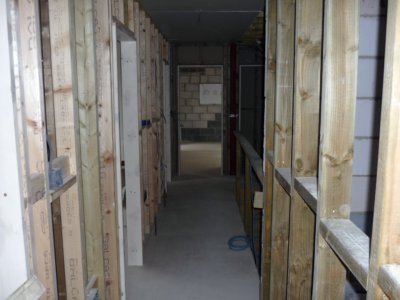 |
You'll oftentimes take to build studwork division walls on site during the framing stages of the job. They tin can be congenital to completely partition a room, divide a large room into two, to grade a corridor or hallway, or build a nib for whatever reason. It'south really important to build them correctly and level/plumb to save yourself loads of problems after on. If you don't get your stud piece of work walls level, yous'll take much more than work making the plasterboard fit, scribing each board in. And, not enough vertical studs will not only mean a weak partition wall that flexes simply you'll take difficulty when it comes to fixing the skirting boards or anything else to it later.
If your interior wall framing is out of level at that place's also a chance the door will swing open up or shut on its own! These are just a couple of the problems that can result from poor interior wall framing and why it'southward worth taking a little fourth dimension to get it right now, that yous'll more relieve later on.
The picture below shows a typical timber segmentation wall, consisting of vertical studs in between the top and bottom plate, and noggings/bridging in between the studs. Noggings add strength/stiffness and are also fitted at the pinnacle where the sheets of plasterboard bring together to prevent movement and swell between the two lath edges.
Typical stud wall components
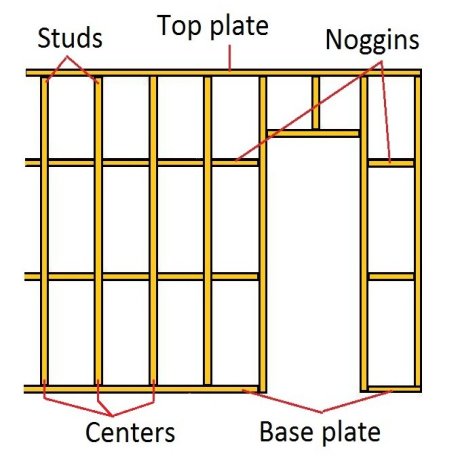
The most common method of interior wall framing is to build them in-situ (in place) on site as opposed to pre-edifice them in a joinery shop and so re-assembling them on site, although some projects require the latter method.
Timber stud walls are generally congenital using either 75x50 (3x2), 100x50 (4x2) or 125x50mm (5x2) timbers to class the pinnacle and bottom plates, studs and noggins. The size to apply and the altitude between studs volition depend on the purpose of the wall - whether or not information technology is structural for example.
Later on framing an interior wall information technology will need to be insulated and sheet material like plasterboard installed. It may besides need a door lining/frame (unless information technology is a solid partition).
Tools and materials I use for interior wall framing:
You don't need loads of particular tools for interior wall framing but having a circular or miter saw and a framing nail gun will relieve a lot of fourth dimension and brand the task easier.
Interior wall framing stride past step:
Footstep one: Select the top and bottom plates
The summit and bottom plates should be the straightest ii lengths of timber in your stack. Find these, and if you lot come up across any really bowed or twisted lengths set these aside to exist cut up into noggings afterwards.
Footstep ii: Cut the floor plate (or sill) and fix down
Cut the lesser plate to the required length, this may be in between 2 external walls for example. I observe the easiest mode to form doorways is to fix the plate downward on to the floor and cut it out later. This helps ensure a straight wall.
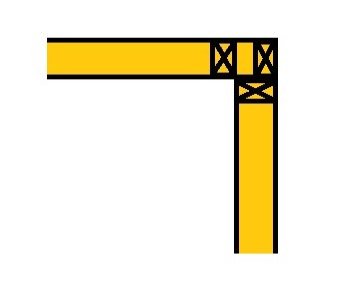
Where at that place is a corner in the studwork wall lay the plates out as in a higher place, with studs in enough places to acquit the plasterboard edges.
If a wall needs to intersect similar a T-shape set out the plates like below so again the studs can comport the plasterboard edges. In between the studs cutting some small noggins to fix and bind everything together with.
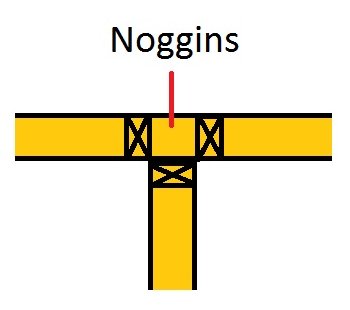
If a door lining needs to be installed at a t-section like above don't fit it tight up confronting the wall. Instead, fit one or two studs starting time so in that location'south enough room to get an architrave up that side of the door, like below.
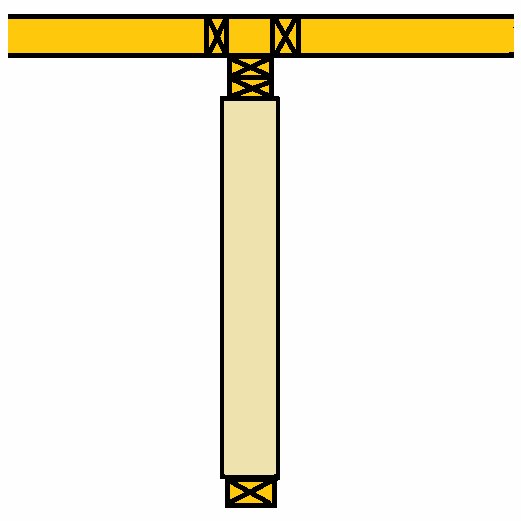
Step iii: Set out studs and transfer to head plate
The number of studs will be on the technical drawing and should relate directly to the size of plasterboard needed. If you are using 2400mm plasterboard for eg. the middle of a stud will measure out 2400 from the cease so where the ends meet they can both be stock-still and supported by the stud. And then more studs are placed in between that and the starting time at equal increments called centres.
Walls are typically built with 400, 450, 500 0r 600mm centres. For this example we will presume 400mm centres, and 2400x1200mm sheets of plasterboard.
Metric and imperial stud/joist/rafter centers
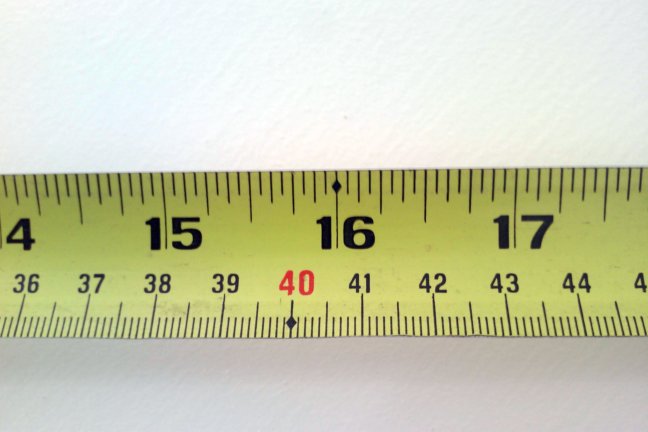
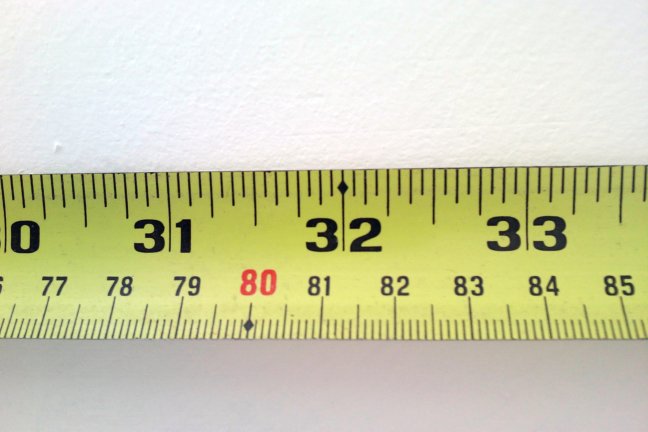
Yous tin can come across in the pictures above that tape measures are marked for setting out centres. At 400 and 800 there is a small black diamond and the numbers are red. In that location's also a blackness diamond at 16" and 32" for those working in imperial. This continues for the length of the tape measure.
There will be a stud at each end, marking out the rest of the stud centres on the floor plate, and lay the top plate on information technology and marking that at the same time. The showtime is 400 and so 800, 1200, 1600 and and then on.
Step 4: Set out doorways
Determine the position of the doorways. In social club to set out the doorway you will need to take these dimensions:
Once calculated set the position of the doorway onto the plates.
Step 5: Fix top plate to ceiling/joists
Plumb a line up from the bottom plate with a long level and a directly edge to mark the position at each end. With the top plate laid on the bottom plate measure down from the ceiling to become the length of the studs required at each end. I add 3-4mm to the measurements and cut two studs.
When interior wall framing on my own I find the easiest way to get the top plate stock-still is to nail the bottom of one stud to the base plate nigh 200mm in from the end and lean the pinnacle of it against the wall. So rest the top plate on that, and elevator the other end up and support it with the opposite stud. From here I can adjust the position of the pinnacle plate before fixing information technology.
Step 6: Cutting base plate out at the doorway
Spiral the base of operations plate either side of the doorway so that it doesn't motion when the plate is cut out. Cut the base plate out with a circular saw (ready to the correct depth)or handsaw.
Step 7: Cutting and set up studs
If the floor and ceiling are level the studs could be cut to the aforementioned lengths otherwise they'll each demand to be measured and cut individually. Accept a list of all the measurements needed, including the two longer ones where the base plate has been cut out. Cut all the studs in one hit, characterization/number each 1 every bit y'all cutting information technology.
Fix them all in place, leaving out the doorway for at present. 75 - 100mm round head wire nails are fine if you don't accept a framing nailgun. three or four skew nailed into the top and lesser of each stud like below.
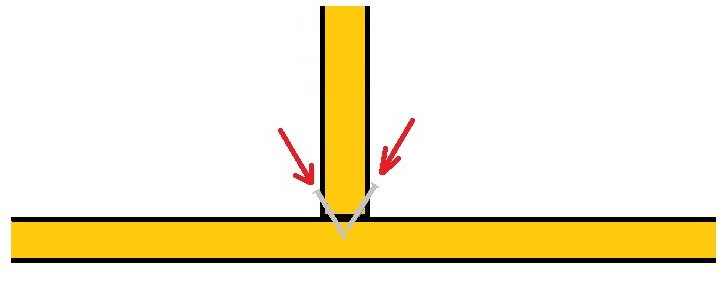
Stride ix: Fit the doorway header
Cutting a piece of timber to the aforementioned width as the gap between the doorway studs on the floor. This is of import, so as to go on the studs parallel in case they bow in/out a picayune. The height to fix this at is calculated by adding;
When nailing this in place use a spirit level to double check as well then your interior wall framing is spot on.
Step 9: Cut and fix noggins/bridging
The noggings, blocking or bridging as they are sometimes chosen are fitted to add together force and carry edges of the plasterboard between studs. The height they are fitted at will depend on the size of the boards, 900 wide boards and the noggings need to be 900mm off the flooring, to the heart. 1200mm boards and they need to be 1200 and then on.
All the studs should be level, only may bow a niggling so get a cutting list for all the noggings by measuring the distances in betwixt them downwards where they're nailed to the base plate. That way when they are fitted at the right height they'll help to straighten up the studs.
Click here for lots more information nearly cutting and installing noggins
Step ten: Install the door linings
Once the stud work wall is complete install the door linings and so they are plumb, level and in wind.
Have a comment or question about interior wall framing?
Source: https://www.carpentry-tips-and-tricks.com/Interior-wall-framing.html
Posted by: nethertonwitesse.blogspot.com


0 Response to "How To Install A Stud Wall"
Post a Comment